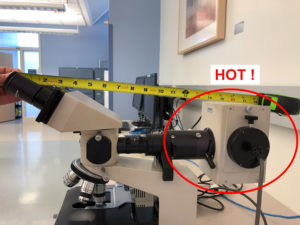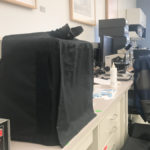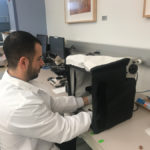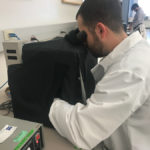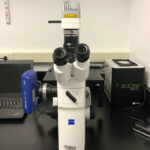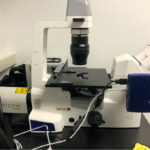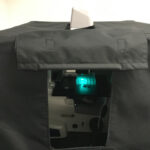Custom Microscope ‘Dark Tent’ Solves Workflow Challenges
NIGHTSEA has provided customized versions of the the standard NIGHTSEA Eclipse MicroTent™ , which was designed for conventional small stereo microscopes. The custom darkness enclosures can be created for a wide range of larger microscope installations with associated light sources, cameras, etc. This page describes two such applications.
Note – As of 2023 the custom tents will be provided through Seafluor Consulting.
A custom NIGHTSEA Eclipse MicroTent™ enables a clinical hematology laboratory to perform a sensitive fluorescence-based blood analysis in their well-lit space, and a biosciences company to use their microscope in still-evolving lab spaces
Darkness Challenge 1
A hematology laboratory in a hospital had an ongoing workflow problem. One of their significant blood test procedures is based on fluorescence, and while they owned an appropriate microscope the blood lab is a large, open, well-lit room (Figure 1). Fluorescence microscopy is typically done in darkened areas, and they could not see the fluorescence from their very small targets reliably because of the strong ambient light.
(Click image for larger view)
When a patient is suspected of being infected with the parasites associated with either malaria (transmitted by mosquitoes) or babesiosis (transmitted by ticks), a blood sample is sent to the laboratory. The sensitive Quantitative Buffy Coat (QBC) method is used for the screening. QBC involves centrifugation of the blood in the presence of a fluorescent stain that attaches to the parasites. A fluorescence microscope is then used to examine the sample.
The laboratory’s Olympus Model BH2 compound fluorescence microscope with the BH2-RFL light source sat unused. In its place they used the same model microscope owned by another group in the hospital. That microscope was in a dimly lit area that made the assay possible, but there were some significant downsides – they could only use the equipment on a non-interference basis; the other group was on a different floor; and the microscope was inside a Biosafety Level 2 (BSL-2) negative pressure room used for tuberculosis testing, requiring special preparation just to enter the room. This all combined to make it an inconvenient arrangement that got in the way of a smooth workflow.
The quest
The lab was considering renovating a storage closet or building an enclosure within their space just to house their microscope, and they were also searching for less intrusive (and expensive) solutions. Technicians at the laboratory learned about the NIGHTSEA Eclipse MicroTent™, a patented (US Pat. No. 10,175,467) ‘dark tent’ solution for shielding microscopes from ambient light and approached us see if our product could assist them.
The solution
Our standard MicroTent™ is made for small stereo microscopes and would not fit around the lab’s compound microscope. We had already been thinking about ways to be more versatile in providing custom solutions and decided to take this project on as a test case. To start the process the lab sent us detailed photographs from various angles with a tape measure in place. One important consideration was that the light source is a 100W mercury vapor bulb and the lamp housing and the optic tube leading to the microscope get very hot (Figure 2).
We designed a new enclosure tailored to the Olympus BH-2 (Figure 3) and then collaborated with the lab to test prototypes and iterate to a final form. The light-restricting material is a true blackout fabric that is supported by a framework of plastic tubing and elbows custom cut for the project. The microscope eyepieces project through a flexible sleeve on the top of the enclosure. The design leaves the hot lamp housing and optic tube outside the tent. The front of the enclosure lifts up to allow easy access to the microscope stage and to the positioning and focusing controls (Figure 4). The tent prevents interfering ambient light from reaching the sample, and the included NIGHTSEA Tru-Block Eye Shields block light from the user’s peripheral vision (Figure 5).
- Fig. 3 – Custom enclosure in place over the microscope
- Fig. 4 – Front flap opens to allow access to microscope stage and controls
- Fig. 5 – Using the microscope and enclosure to examine blood samples
With the tent in place laboratory personnel can now perform QBC tests at their convenience. The laboratory director wrote:
“Thank you for solving an operational workflow dilemma! The dark tent will be helpful for performing microscopy while saving the expense of a dark room and increasing the testing portability.”
Darkness Challenge 2
A biosciences company needed to be able to use a Zeiss Axiovert A1 inverted fluorescence microscope without a dedicated dark room, in laboratory spaces that were still in flux. The microscope was fitted with various accessories including a camera, a CoolLED light source, and associated power and signal cables.
(Click any image for larger view)
Working in consultation with the customer we designed an enclosure with appropriate features:
- Light-limiting penetrations for the eyepieces and the top-light cooling
- Arm slits in the front for reaching camera controls
- Openings on either side with cover flaps, for inserting samples
- Room for the stage to move full travel from side to side
- Front view of custom tent, showing eyepieces and arm slots
- Side view of custom tent, with flap over access port in raised position
- Custom tent in use
The project was successful. From the customer:
We’re really enjoying the tent. Our lab spaces have already shuffled a few times since we’ve had the tent, and it’s nice to know that the scope is useable wherever it fits.
Do you need a custom darkness solution for your microscopy? Contact NIGHTSEA for more information.


